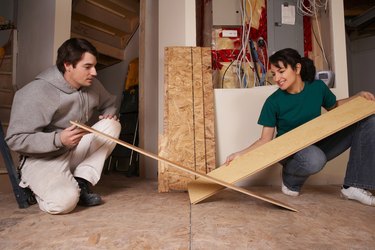
Subflooring is the rough unfinished floor beneath a finished floor, sometimes referred to as a blind floor. During home construction, a builder installs subflooring to provide a solid level foundation for finished flooring such as tile, wood, vinyl or linoleum. Subflooring doesn't generally provide the aesthetic beauty, protected surface or functionality that finished flooring provides.
Durability
Video of the Day
Consider durability factors related to your subflooring. According to Hosking Hardwood, most subfloors are constructed out of plywood, pine boards, oriented strand board or concrete. The first three are made from natural woods and are generally less than 3/4 inch thick. Well-constructed subflooring is built to withstand the weight of interior walls, a roof, household furniture, finished flooring, and people. However, wood subflooring isn't designed to accommodate daily wear-and-tear, moisture or soiling. Concrete subflooring is generally durable enough to withstand daily use.
Video of the Day
Subflooring Viability
Determine whether your subflooring is structurally sound. According to Hosking Hardwood, many homes are built with "weak foundation footings, improperly spaced support columns, improperly spaced floor joists or weak improperly nailed subflooring." As a result, failing subfloors have movement, sagging soft spots, unequal levels, separation and excessive squeaking. The University of Florida reports that plywood subfloors often separate when exposed to moisture, causing areas to warp or buckle. Repair or replace damaged subflooring or it might not provide viable support as regular flooring.
Aesthetics
Evaluate the visual appearance of your subflooring. If your subfloor is concrete and doesn't contain visible cracks, chips or discolorations, you might choose to keep it as your regular flooring. Paint or stain concrete subflooring if you want to give it a finished appearance. Plywood, pine boards and OSB subflooring generally have an unfinished appearance. Because the boards are not sanded to a smooth finish or colored with visually appealing stains and glossy overcoats, the subflooring has primitive, rustic characteristics and splintery edges.
Long-term Practicality
Invest in practical flooring that serves a long-term purpose. Wood subflooring isn't designed to be the top layer of flooring. Well-constructed wood subflooring is sturdy, but using it as regular flooring could damage its surface and reduce its lifespan. According to MSN Real Estate, plywood can mold, rot and become brittle because of moisture and sun exposure, if it's left uncovered for a period of time. Concrete subflooring is acceptable as regular flooring, as long as it's in a moisture-proof environment. Consider the long-term effects of leaving your subflooring exposed.